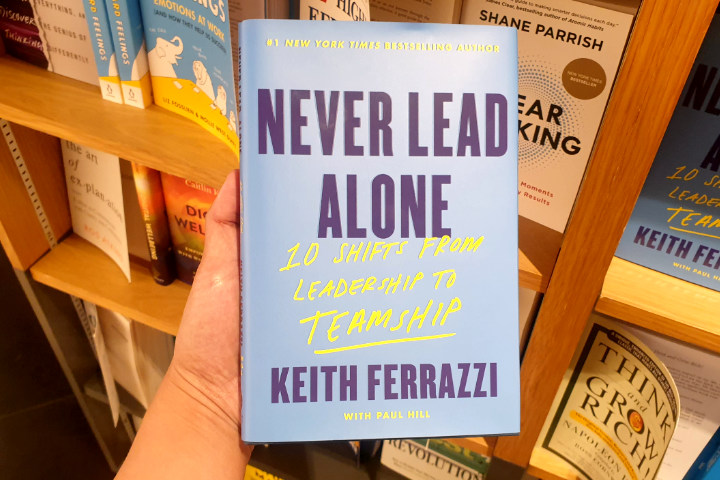Never Lead Alone authored by Keith Ferrazzi challenges the traditional notion of leadership by flipping the script on what it truly means to lead effectively.
Far too often, leadership is portrayed as a solitary pursuit, where the leader is the lone figure at the top, making decisions in isolation.
Ferrazzi dismantles this notion, arguing instead that leadership is fundamentally about relationships and connections with the people around you.
It’s about creating a network of people who trust you and rely on you. Not because you hold authority over them, but because you’ve fostered genuine connections that empower and elevate those around you.
What sets the book apart from other leadership books is how it advocates a core belief that leadership is a shared responsibility. It’s not a steoreotypical top-down hierarchy, but rather a collaborative effort where everyone has a role to play in helping each other succeed.
Ferrazzi’s call to action is simple yet profound.
Successful leaders are those who are able to build and nurture authentic relationships without selfish motives.
To him, leadership is a service. A way to help others reach their fullest potential, while also growing in the process.
How great a leader you are is really about how great a team you have built.
While the book title is a rather catchy phrase, it is really an open invitation to reimagine leadership.
It stresses that leaders who try to go it alone are doomed to fail.
Leadership is a shared journey, one that thrives on trust, collaboration, and the support of others.
The best leaders understand that they need a strong support network to achieve their goals. And to inspire by bringing out the best in those they lead.
This perspective challenges the toxic, individualistic approach to leadership that often permeates corporate culture. And offers a refreshing vision of leadership as a community-centered practice built on mutual respect and genuine care for others.
The manner of writing found in this book is deeply personal. Where the author draws on his own experiences as a high-level executive and leader in business.
His personal stories are filled with both triumphs and failures, and helps ground his theory in reality. He doesn’t sugarcoat the challenges that come with building meaningful relationships or being vulnerable in the workplace.
He acknowledges that it takes time, effort, and a deep understanding of human nature to cultivate trust. At the same time insisting that the return on investment is priceless.
Leaders who prioritize relationships not only create more cohesive and productive teams but also foster environments where innovation, loyalty, and growth are the natural byproducts.

At the heart of the book’s theme is about empowering others to rise.
The concept of “collaborative leadership” is a framework where leaders and teams engage in open, honest communication and mutual support. A leader who listens actively, fosters transparency, and encourages everyone to contribute their ideas and talents.
It is argues that the role of a leader is not to be the one with all the answers, but to be the person who asks the right questions. This encourages diverse perspectives, and creates an environment where everyone feels like they belong.
This is, at its core, a leadership philosophy rooted in humility and empathy. Qualities that are often overlooked in more traditional models.
One of the book’s key insights is how leaders can expand their influence by creating “alliances” rather than merely “networks.”
There is a crucial distinction between these two concepts.
A network is a collection of contacts that may or may not offer any real value. An alliance is built on trust, shared goals, and mutual respect.
Alliances are sustainable relationships that go beyond superficial interactions. They are partnerships that endure, built on a foundation of giving and receiving in equal measure. In other words, it’s not about who you know, but who you trust, support, and collaborate with.
A great leader is not a lighthouse—sitting still and casting a beam of light. Instead, a great leader is a bridge—offering a way to connect and move forward, even when the path ahead is uncertain.
Don’t undervalue the importance of emotional intelligence in leadership. As great leaders possess the ability to read people, understand their needs, and respond with empathy.
For example, if a team member comes to you with a personal issue that is affecting their work performance. Instead of brushing off the concern or focusing solely on the task at hand, take the time to listen, empathize, and offer support. The result will not only be a stronger relationship with the team member but also an improvement in their performance, as they will feel understood and respected.
This emotional acumen of leaders is what allows them to connect with others on a deeper level, ensuring that their leadership is both effective and humane.
A leader must first be able to connect with your own emotions and the emotions of others.
This concept is usually overlooked in more analytical or results-driven leadership models. But is essential for creating a thriving, cohesive team that feels valued and motivated.
The fact is that building these kinds of relationships takes work. It requires consistency, vulnerability, and a willingness to put yourself out there.
So one should have regular check-ins, personal follow-ups, and meaningful gestures of appreciation as some of the key strategies for developing strong, lasting relationships. And yet, it must be emphasized that leadership isn’t just about constantly being on the go, trying to maintain a million relationships at once.
It’s about quality over quantity.
A few genuine, deeply-rooted relationships are far more valuable than a wide network of superficial contacts.
The book’s pragmatic advice, filled with personal stories and hands-on tips, provides readers with a toolkit for being more intentional in their leadership and connection-building.
What resonated most with me is the insistence on giving without expectation.
The author advocates for “servant leadership”. Which is the idea that great leaders are the ones who put the needs of their people first. This is where his concepts really stand out.
You will find a lot on tactical leadership skills. And about creating a culture of generosity and support.
Leaders are encouraged to be the ones who give the most, whether through mentorship, coaching, or simply being there for others in times of need.
It’s a leadership style that isn’t concerned with power or control, but with empowerment and the collective success of the group.
There’s also a delightful bit of humor in Ferrazzi’s writing, sprinkled throughout with moments that will make you smile. His ability to balance business advice with lighthearted moments is a testament to the engaging and accessible style of the book.
As a leader, you’ll need to wear many hats—just make sure they all fit, or you might end up with egg on your face.
He knows that leadership can be serious business, but he also understands the importance of being human in building strong teams. After all, a little laughter can go a long way in breaking down walls and fostering true connections.
Perhaps it’s his way of reminding us that a good leader isn’t just someone who commands respect. They’re also someone you’d want to share a cup of coffee (or maybe even lunch) with.
This book is a call to action for managers who wish to transform their approach to leadership and connect with others on a deeper level.
And the overall message is simple but powerful.
Leadership is about relationships, not hierarchy. Service, not power. And collaboration, not competition.
Biggest Takeaway
No leader can truly lead alone whether it’s in business, community, or life.
Leadership should be collaborative, not hierarchical, and the true strength of a leader lies in their ability to build trust, communicate openly, and support the growth of those they lead.
A profound shift from traditional models of leadership that focus on authority and control.
Empower others, building meaningful alliances, and be a part of something larger than yourself.
The perspective shifts the focus from managing tasks to cultivating relationships, offering a framework for building trust, empathy, and collaboration in the workplace.
It is a guide to creating those lasting connections that not only transform careers but also enrich lives. That’s a vision of leadership we can all get behind.




